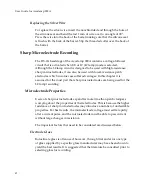
Guide
to
Electrophysiological
Recording
used
for
a
given
average
gain
(G).
The
stability
criterion
is
(see
Brenneke
&
Lindemann,
1974;
Finkel
&
Redman,
1985):
2
0
<
<
s
m
f
C
G
For
critical
damping
we
require:
1
=
s
m
f
C
G
Thus
for
a
given
G,
if
C
m
is
small
f
s
must
be
large.
As
an
example,
if
G
=
1
nA/mV
and
C
m
=
100
pF,
then
f
s
must
be
10
kHz
for
critical
damping.
If
f
s
is
less
than
10
kHz
in
this
example,
the
step
response
will
overshoot
and
at
5
kHz
the
clamp
will
oscillate
destructively.
If
the
sampling
rate
in
this
example
cannot
be
as
great
as
10
kHz
because
the
microelectrode
response
is
too
slow,
then
a
lower
value
of
G
will
have
to
be
used
to
maintain
stability.
Clamp
Error
With
finite
gains
in
the
voltage
‐
clamp
circuit
V
m
does
not
quite
follow
V
c
.
The
error
is
ε
=
V
cmd
–
V
m
.
Similarly,
if
V
cmd
is
constant
and
the
cell
membrane
conductance
changes,
then
there
is
an
error
in
the
measurement
of
the
current
underlying
the
conductance
change.
This
error
is
similar
in
percentage
to
the
voltage
error.
Usually
the
gain
of
the
voltage
‐
clamp
circuit
can
be
increased
so
that
ε
is
10%
or
less.
The
percentage
error
depends
on
the
frequency
of
the
command
signal
or
of
the
conductance
change.
It
is
smallest
for
slow
signals
and
DC,
and
largest
for
the
fastest
signals.
Thus
very
fast
transients
(such
as
the
rising
phase
of
synaptic
currents)
will
be
clamped
less
well
than
slower
transients
(such
as
the
decay
phase
of
synaptic
currents).
95
















































